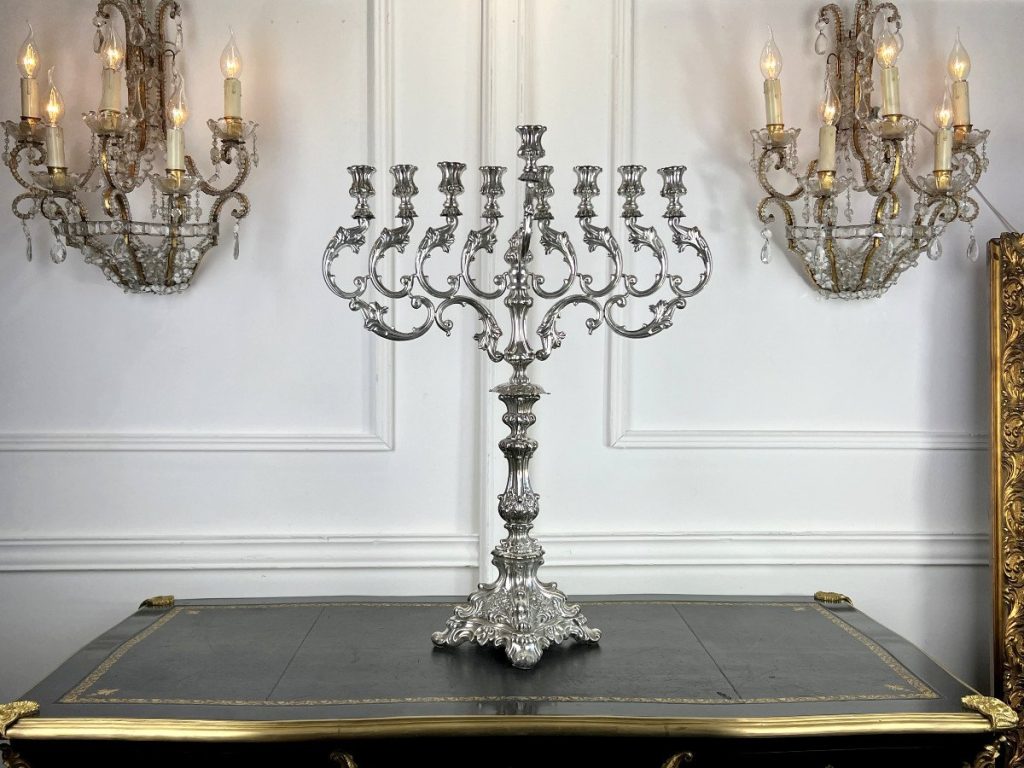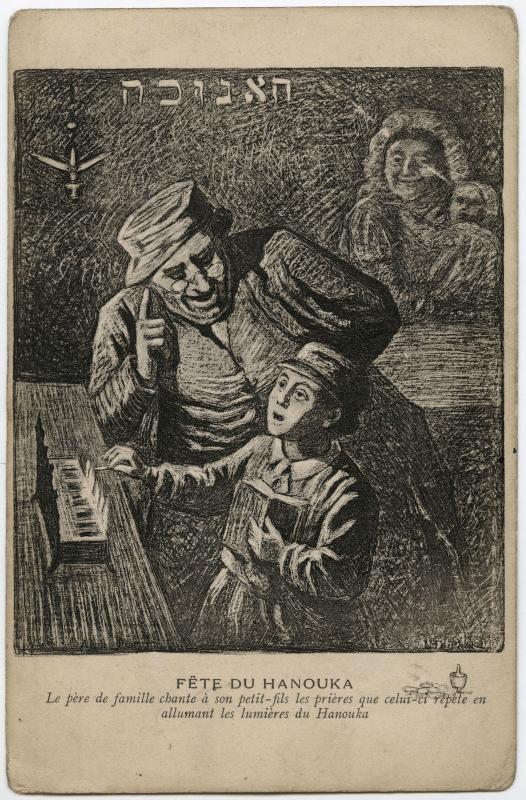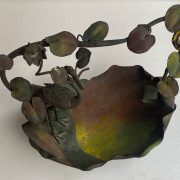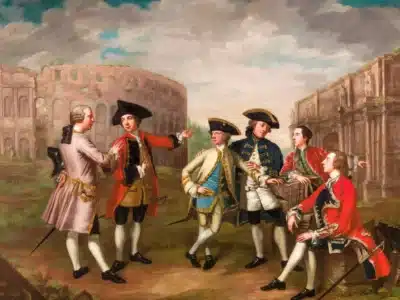Each year, Hanukkah–or Chanukah–, the Festival of Lights, is celebrated from 25 Kislev on (most likely in December) for eight days. This Jewish tradition celebrates faith resilience and the victory of Torah over oppression.

Oil lamp for Hanukkah. Can you spot the shamash? The date palms symbolize prosperity. The lions are most likely Lions of Judah. One is included in the emblem of Jerusalem. © Le Lys et l’Epée
The candelabrum or lamp of 9 branches (including the shamash) is at the center of this celebration. It is called hanukkiah to distinguish it from a standard menorah with 7 branches.

The menorah with 7 branches is a paramount symbol of Judaism. © Thomas Chabolle Antiquités
What Is Hanukkah?
It is about a miracle and a victory.
Hanukkah means ‘inauguration’. It relates to the re-dedication of the Jerusalem Second temple once it was won by the Maccabees over the Seleucids (a Hellenistic dynasty ruling over Syria and Mesopotamia from Antioch) in 165 BC. This event closes the Maccabean revolt and is a victory to re-instate Jewish traditions.

A depiction of the Temple in an Atlas of the Vence Bible, 1825. © Histoire Sans Fin
After their victory, the Maccabees wanted to purify the Beit Hamikdash by lighting up a 7-branched candelabrum. They realized they only had one-day worth of sacred oil. However, the oil miraculously lasted for eight days in total, giving enough time to get more consecrated oil.
This miracle symbolizes the resistance of faith. However small the flame of faith is, it can be revigorated and shine beyond all expectations.
This celebration was originally a minor holiday as it is not mentionned in the Bible. The Hanukkah ritual first appeared in the Gemara. Nevertheless, nowadays Hanukkah is heavily followed by Jews across the globe. It is a cheerful celebration where the kids play with dreidels and people eat latkes (potato pancakes) and sufganiyot (jelly doughnuts).

Boys playing the dreidel (or sevivon) in 1934. The dreidl carries the four Hebrew letters nun, gimel, hay, and shin standing for Nes Gadol Hayah Sham “a great miracle happened there”. Jewish Museum Berlin © Herbert Sonnenfeld
Hanukkiah: Oil Lamps or Candelabra

A sterling silver Hanukkah menorah. © Leleu Antiquités
A hanukkiah can be an oil lamp or a candelabrum. Using an oil lamp with olive oil enables to reproduce the original celebrated event of the sacred oil miracle more closely. But both a lamp or candelabrum are totally acceptable. What matters is to generate a steady light. Historically, olive oil was easier to find in some regions while difficult in some others, which explains why candles have been used.

A Moroccan Hanukkah lamp in brass. Early 20th century (or older). © Galerie Cécile Kerner
In all cases, there is always a shamash (meaning ‘servant’) light, set separately from the others, used exclusively to start the other lights.

Shamash close-up on a Hanukkah oil lamp. You can also notice the small tubes for the wick in each oil receptacle. © Blanès
Additionnally to the shamash, an oil lamp has 8 receptacles and a candelabrum has 8 branches.

A 19th-century silver hanukkiah from Posen, Germany. Despite the candelabrum look, it is in fact an oil lamp. © Blanès
The lights need to be aligned and at the same height.

The eight lights are aligned in this Hanukkah lamp and this candelabrum. On the left, a 19th-century Hanukkah lamp in copper and brass from the Netherlands © Au Fil du Temps Belgium. On the right, a Hanukkah candelabrum in sterling silver © Leleu Antiquités.
As described in the Bible, the original menorah was of pure gold. Obviously, not many could afford a menorah in pure gold. Many ancient oil lamps were in terracotta. Most of the antique hanukkiahs around these days are metallic. The examples displayed on this page are in silver, bronze, copper or brass.

19th-century Hanukkah lamp in sterling silver. © Leleu Antiquités
Let There Be Light: Lighting Up the Hanukkiah
Each evening of Chanukah, an appropriate number of lights are lit. The most common practice is to light one more candle each night: one candle the first night, two candles the second night, etc. The candles or lamps are set up from the right and ignited from the left with the shamash.

For Hanukkah, a grandfather and grandson say the prayers while lighting up the lights. © MahJ
It can happen from sunset on and before people go to bed. The lights need to burn for at least 30 minutes after the sun has set. Ideally, in order to publicize the miracle, people need to be able to see it from the street. It could be by the door of a house (at least above 30 centimeters) or commonly on a window sill (but less than 10 meters high).

“Judah will live forever” say the lights of this Hanukkah menorah across the Nazi flags in Kiel, Germany in 1931. Rachel Posner, wife of Rabbi Akiva Posner, took this picture and annotated it. © Yad Vashem
You May Like
Judaica | Vintage & Antique Menorah | Judaica Category | Synagogue Chandeliers & Artefacts | Jewish Arts











